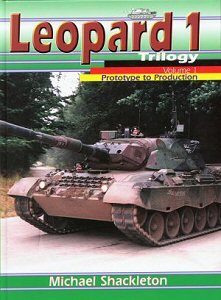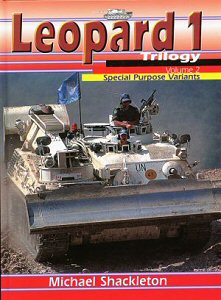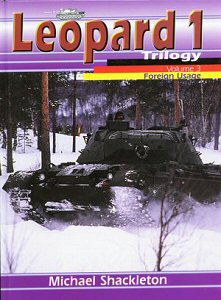




The Leopard tank is also the basis for a series of related vehicles which means any account has a lot of different vehicles to cover. Any good book will need to be big, and may cover areas which are not to everyone's taste or else deal with some in more detail than others. The publishers have issued this account in separate volumes which allows the reader to concentrate on one or more separate area or else to purchase all three parts, at one go or in stages, as they choose.
Prototype to Production covers the basic tank from its early days, right back to three initial options including one with some unusual and advanced features for its day which only existed as a paper project. The two more conventional designs were produced as a series of prototypes which were tested along with French proposals before a single design was chosen for full development. This progression is followed using drawings, original black and white record photos and pages of colour detail views of surviving machines. Production tanks are then shown in great detail, using lots of general and close-up views to show changes in design of the Leopard. These range from the original form with cast turret, the improved cast version, later welded design and older cast-turret tanks modernised with extra armour. Modellers can follow these changes using eight sets of 1/35th scale plans and photos together text descriptions and sketches showing how items such as headlights, stowage and sights were changed during production and refits. These many variations are neatly summarised in a single table showing what was changed and when to allow identification of a tank by its original build-standard for those who like order or complexity.
A detailed description of the gun tank itself is given, with photos showing the engine and gearbox in place and on their own as well as a pages of photos of the inside of the tanks and extracts from the original user manuals which should please anyone wanting to produce a detailed interior. Various one-off prototypes are also shown, including an advanced fully-stabilised turret and proposed upgunned tanks mounting the 120mm gun used in the Leopard 2 series. A listing of those German Army units using Leopard 1 is given, as well as accounts of the vehicles training German units in Wales and Canada.
Final chapter lists Leopard models in scales from 1/300 to 1/16, with an appraisal of better and poorer points of each along with update sets which are available for them. Together with the plans and photos in the book, modellers should have more than enough material to build a good model.
The Special Purpose Variants volume provides a similar level of detail on the numerous family vehicles. Often with tank books, these related vehicles are not described in as much detail as the basic tanks but this is not the case here. Often overlooked, all are important to the smooth running of an armoured unit and from a modeller's viewpoint they usually make a tank model look easy and almost boring. The full range is described, original Bergepanzer recovery vehicle and the new Belgian-designed version for Brazil, three different engineer versions, several mine-clearing tanks, a range of anti-aircraft vehicles from early ideas to the production Gepard for the German Army and the Dutch Cheetah version as well as experimental Marksman and OTOMATIC add-on turrets, Biber and Leguan bridgelayers plus experimental alternative designs, the special driver-training cab, unarmed artillery observation tanks, the latest Beach Armoured Recovery Vehicles designed for the Dutch and British forces and even a heavy fire-fighting vehicle as well as several unsuccessful designs on the base chassis. Photos, plans, manual and brochure extracts will inspire many modellers to start converting as most versions are not available at least as plastic kits.
Final volume covers Foreign Usage which covers Leopard outside its native Germany. Long a major part of the NATO tank force, several nations used them from Norway and Denmark in the North down through Belgium, Italy - who also built them under licence - and through to Greece and Turkey as well as Canada who used them in NATO Europe contingent as well as at home. Also far from home are the Australian tanks which have many unique fittings including a combined camouflage and heat shield system and an instructors seat outside the turret, while second-user tanks have been supplied to Chile and many others were transferred to Greece who now operate a very varied fleet while several users now combine parts from more than one original model to make a wide range of different types. Several countries had features specific to their own needs, ranging the same radios and machine guns as their usual type as well as different gun sights and stowage while there were separate upgrade programs in many countries. These are the changes which make tank modelling interesting, the differences are shown in pages of photos as well as six sets of plans. Special uparmour kits for Canada and the camouflage matting system used in Denmark are unusual to say the least. To support the basic tanks, most operators have one or more of the specialist versions, and these are all covered together with details of colour and marking schemes and accounts of the tanks in use. Especially valuable for modellers are closeup photos of various mine ploughs and rollers, some of which are used by several countries.
It is hard to separate the subjects completely and the foreign section especially often refer to the first two volumes for more details of the basic vehicles and chapters and page numbers follow on through the separate books. Each of the three volumes is to the same high standard, using plans, drawings and a large number of mostly colour photos throughout to give very comprehensive coverage. Technical descriptions are written in a readable manner, while the listing of users are grouped together to make them easy to follow. The author has collaborated with many others right across the world to produce a one-source account of Leopard in all its forms. A huge amount of detail has been included in the whole 600 pages. I suspect that while some may be put off by the total price they will find the series fantastic value compared to buying several books on parts of the whole story, and many who start off buying just one volume will want to get the one or both the others to have the overall picture.
Page created 16 September 2003